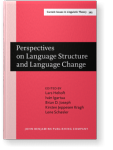Changes of tense and modality in Late Mediaeval Slovene
Transference, extension or both?
The paper analyses the typology of change processes proposed by Andersen (2001, 2006) by minutely investigating semantic and pragmatic properties of temporal categories in the earliest Slovene texts, which emerged under German cultural influence, but preserved primacy of system-motivated developments.
Article outline
- 1.Introduction
- 2.Slovene between the Freising fragments and the Rateče manuscript
- 2.1The past tenses in the Freising fragments
- 2.2The Rateče manuscript
- 3.Trubar’s Catechismus 1550: How much did Luther’s Catechismus influence Trubar’s Slovene
- 4.Conclusions
-
Abbreviations
-
Notes
-
References
References (30)
References
Andersen, Henning. 2013. On the origin of the Slavic aspects: Imperfect and aorist. In Laura A. Janda & Tore Nesset (eds.), Aspect in Slavic: Creating time, creating grammar. Special issue of Journal of Slavic Linguistics 21. 17–44.
Barentsen, Adrian. 1998. Priznak «sekventnaja svjaz'» i vidovoe protivopostavlenie v russkom jazyke [The feature 'sequential connection' and the aspectual opposition in Russian]. In M. Ju. Čertkova (ed.), Tipologija vida. Problemy, poiski, rešenija, 43–58. Moskva: Škola «Jazyki russkoj kul'tury».
Comrie, Bernard. 1975. Tense. Cambridge University Press.
Dentler, Sigrid. 1997. Zur Perfekterneuerung im Mittelhochdeutschen. Göteborg: Acta Universitatis Gothoburgensis.
Dickey, Stephen M. 2000. Parameters of Slavic aspect: A cognitive approach. Stanford: Center for the Study of Language and Information (CSLI).
Drinka, Bridget. 2017. Language contact in Europe. The periphrastic perfect through history. Cambridge University Press. 

Eckhoff, Hanne M. & Laura A. Janda. 2013. Grammatical aspect and profiling in Old Church Slavonic. Transactions of the Philological Society 112(2). 231–258. 

Fischer, Hanna, 2016. Präteritumschwund im Deutschen. Dissertation. Universität Marburg.
Grafenauer, 1958. Celovški rokopis iz Rateč [The Celovec manuscript from Rateče]. Rasprave SAZU 2(3). 5–63.
Gvozdanović, Jadranka. 1989. O akcentu i vokalskom kvalitetu u Brižinskim spomenicima. Slavistična revija 37. 39–49.
Gvozdanović, Jadranka. 2012. Perfective and imperfective aspect. In Robert L. Binnich (ed.), The Oxford handbook of tense and aspect, 781–802. Oxford: Oxford University Press.
Gvozdanović, Jadranka. 2016. Aspects of Indo-European historical syntax in a typological perspective. Slovo a slovesnost 77. 416–434.
Holzer, Georg. 1986. Die Reflexe des hinteren Nasalvokals *ǫ in den Freisinger Denkmälern. Wiener slavistisches Jahrbuch 32. 29–35.
Ivanov, Vjačeslav V. 1964. Istoričeskaja grammatika russkogo jazyka [Historical grammar of Russian]. Moskva: Nauka.
Ivanov, Valerij V. 1982. Istorija vremennyx form glagola [History of the temporal verb forms]. In Ruben I. Avanesov & V. V. Ivanov, Istoričeskaja grammatika russkogo jazyka, 25–131. Moskva: Nauka.
Jakobson, Roman. 1956. Shifters, verbal categories, and the Russian verb. Repr. In Jakobson, Roman. 1971. Selected writings II: Morphological studies, 130–147. The Hague: Mouton.
Kiparsky, Paul. 1998. Aspect and event structure in Vedic. In: Yearbook of South Asian languages and Linguistics, 1–27.
Klein, Wolfgang. 1994. Time in language. London: Routledge.
Kortlandt, Frederik. 1975. Jers and nasal vowels in the Freising fragments. Slavistična revija 23. 405–412.
Krvina, Domen. 2015. Glagolski vid v sodobni slovenščini [The verbal aspect in contemporary Slovene]. Doktorska disertacija. Ljubljana: Filozofska Fakulteta.
Maslov, Ju. S. 1948. Vid i leksičeskoe značenie glagola v sovremennom russkomliteraturnom jazyke [Aspect and the lexical meaning oft he verb in contemporary literaryRussian]. Izvestija Akademii nauk SSSR–Otdelenie literatury i jazyka 7(4). 303–316. Moscow.
Merše, Majda. 1995. Vid in vrstnost glagola v slovenskem knjižnem jeziku 16. stoletja. [Aspect and Aktionsart in the Slovene literary language of the 16th century]. Ljubljana: SAZU.
Pinault, Georges-Jean. 1995. Le problème du préverbe en indoeuropéen. In André Rousseau (ed.), Les préverbes dans les langues d’Europe: Introduction à l’étude de la préverbation, 35–59. Lille: Septentrion.
Ramovš, Fran and Milko Kos. 1937. Brižinski spomeniki [Freising fragments]. Ljubljana: SAZU.
Reichenbach, Hans. 1947. Elements of Symbolic Logic. New York: Collier – MacMillan.
Schaeken, Jos. 1987. Die Akzentzeichen im 1. Freisinger Denkmal. Zeitschrift für slavische Philologie
47. 346–351.
Solms, Hans-Joachim. 1984. Flexionsmorphologie des frühneuhochdeutschen Verbs. Dissertation (Universität Halle-Witemberg).
Woodhouse, Robert. 2008. The dual reflexes of Proto-Slavic *ǫ in the Freising Texts. Indogermanische Forschungen 113. 299–311. 

Cited by (2)
Cited by two other publications
Gvozdanović, Jadranka
2020.
Introduction.
Journal of Historical Linguistics 10:2
► pp. 153 ff.

This list is based on CrossRef data as of 29 july 2024. Please note that it may not be complete. Sources presented here have been supplied by the respective publishers.
Any errors therein should be reported to them.
